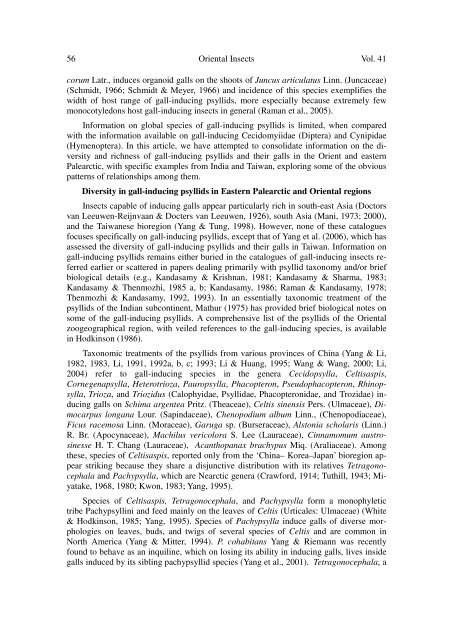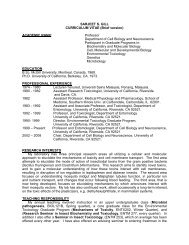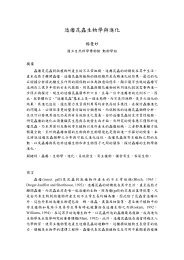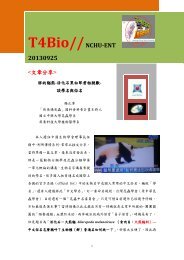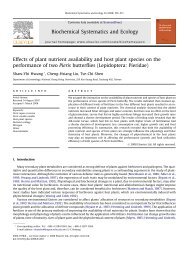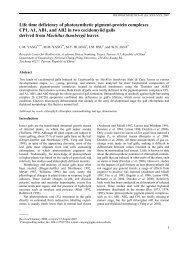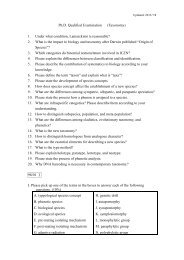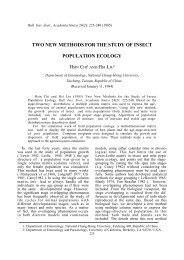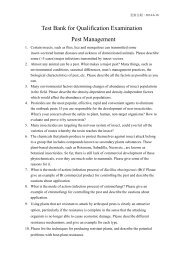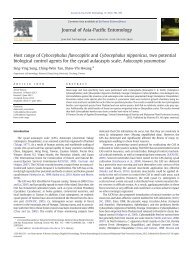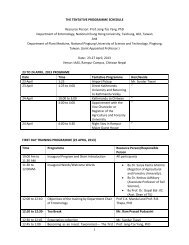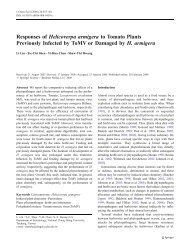diversity, richness, and patterns of radiation among gall-inducing ...
diversity, richness, and patterns of radiation among gall-inducing ...
diversity, richness, and patterns of radiation among gall-inducing ...
Create successful ePaper yourself
Turn your PDF publications into a flip-book with our unique Google optimized e-Paper software.
56 Oriental Insects Vol. 41corum Latr., induces organoid <strong>gall</strong>s on the shoots <strong>of</strong> Juncus articulatus Linn. (Juncaceae)(Schmidt, 1966; Schmidt & Meyer, 1966) <strong>and</strong> incidence <strong>of</strong> this species exemplifies thewidth <strong>of</strong> host range <strong>of</strong> <strong>gall</strong>-<strong>inducing</strong> psyllids, more especially because extremely fewmonocotyledons host <strong>gall</strong>-<strong>inducing</strong> insects in general (Raman et al., 2005).Information on global species <strong>of</strong> <strong>gall</strong>-<strong>inducing</strong> psyllids is limited, when comparedwith the information available on <strong>gall</strong>-<strong>inducing</strong> Cecidomyiidae (Diptera) <strong>and</strong> Cynipidae(Hymenoptera). In this article, we have attempted to consolidate information on the <strong>diversity</strong><strong>and</strong> <strong>richness</strong> <strong>of</strong> <strong>gall</strong>-<strong>inducing</strong> psyllids <strong>and</strong> their <strong>gall</strong>s in the Orient <strong>and</strong> easternPalearctic, with specific examples from India <strong>and</strong> Taiwan, exploring some <strong>of</strong> the obvious<strong>patterns</strong> <strong>of</strong> relationships <strong>among</strong> them.Diversity in <strong>gall</strong>-<strong>inducing</strong> psyllids in Eastern Palearctic <strong>and</strong> Oriental regionsInsects capable <strong>of</strong> <strong>inducing</strong> <strong>gall</strong>s appear particularly rich in south-east Asia (Doctorsvan Leeuwen-Reijnvaan & Docters van Leeuwen, 1926), south Asia (Mani, 1973; 2000),<strong>and</strong> the Taiwanese bioregion (Yang & Tung, 1998). However, none <strong>of</strong> these cataloguesfocuses specifically on <strong>gall</strong>-<strong>inducing</strong> psyllids, except that <strong>of</strong> Yang et al. (2006), which hasassessed the <strong>diversity</strong> <strong>of</strong> <strong>gall</strong>-<strong>inducing</strong> psyllids <strong>and</strong> their <strong>gall</strong>s in Taiwan. Information on<strong>gall</strong>-<strong>inducing</strong> psyllids remains either buried in the catalogues <strong>of</strong> <strong>gall</strong>-<strong>inducing</strong> insects referredearlier or scattered in papers dealing primarily with psyllid taxonomy <strong>and</strong>/or briefbiological details (e.g., K<strong>and</strong>asamy & Krishnan, 1981; K<strong>and</strong>asamy & Sharma, 1983;K<strong>and</strong>asamy & Thenmozhi, 1985 a, b; K<strong>and</strong>asamy, 1986; Raman & K<strong>and</strong>asamy, 1978;Thenmozhi & K<strong>and</strong>asamy, 1992, 1993). In an essentially taxonomic treatment <strong>of</strong> thepsyllids <strong>of</strong> the Indian subcontinent, Mathur (1975) has provided brief biological notes onsome <strong>of</strong> the <strong>gall</strong>-<strong>inducing</strong> psyllids. A comprehensive list <strong>of</strong> the psyllids <strong>of</strong> the Orientalzoogeographical region, with veiled references to the <strong>gall</strong>-<strong>inducing</strong> species, is availablein Hodkinson (1986).Taxonomic treatments <strong>of</strong> the psyllids from various provinces <strong>of</strong> China (Yang & Li,1982, 1983, Li, 1991, 1992a, b, c; 1993; Li & Huang, 1995; Wang & Wang, 2000; Li,2004) refer to <strong>gall</strong>-<strong>inducing</strong> species in the genera Cecidopsylla, Celtisaspis,Cornegenapsylla, Heterotrioza, Pauropsylla, Phacopteron, Pseudophacopteron, Rhinopsylla,Trioza, <strong>and</strong> Triozidus (Calophyidae, Psyllidae, Phacopteronidae, <strong>and</strong> Trozidae) <strong>inducing</strong><strong>gall</strong>s on Schima argentea Pritz. (Theaceae), Celtis sinensis Pers. (Ulmaceae), Dimocarpuslongana Lour. (Sapindaceae), Chenopodium album Linn., (Chenopodiaceae),Ficus racemosa Linn. (Moraceae), Garuga sp. (Burseraceae), Alstonia scholaris (Linn.)R. Br. (Apocynaceae), Machilus vericolora S. Lee (Lauraceae), Cinnamomum austrosinesseH. T. Chang (Lauraceae), Acanthopanax brachypus Miq. (Araliaceae). Amongthese, species <strong>of</strong> Celtisaspis, reported only from the ‘China– Korea–Japan’ bioregion appearstriking because they share a disjunctive distribution with its relatives Tetragonocephala<strong>and</strong> Pachypsylla, which are Nearctic genera (Crawford, 1914; Tuthill, 1943; Miyatake,1968, 1980; Kwon, 1983; Yang, 1995).Species <strong>of</strong> Celtisaspis, Tetragonocephala, <strong>and</strong> Pachypsylla form a monophyletictribe Pachypsyllini <strong>and</strong> feed mainly on the leaves <strong>of</strong> Celtis (Urticales: Ulmaceae) (White& Hodkinson, 1985; Yang, 1995). Species <strong>of</strong> Pachypsylla induce <strong>gall</strong>s <strong>of</strong> diverse morphologieson leaves, buds, <strong>and</strong> twigs <strong>of</strong> several species <strong>of</strong> Celtis <strong>and</strong> are common inNorth America (Yang & Mitter, 1994). P. cohabitans Yang & Riemann was recentlyfound to behave as an inquiline, which on losing its ability in <strong>inducing</strong> <strong>gall</strong>s, lives inside<strong>gall</strong>s induced by its sibling pachypsyllid species (Yang et al., 2001). Tetragonocephala, a


